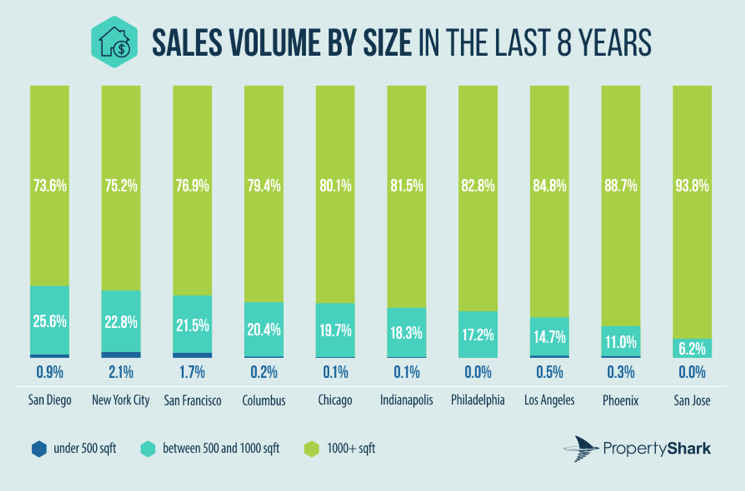The trend towards so-called “tiny homes” has attracted a lot of attention in recent years, with some expert saying their affordability may help to address housing shortages in many markets. But new data from PropertyShark suggests that smaller living spaces aren’t proving to be all that popular.

PropertyShark said in its report that even in the priciest markets, where homeowners have more incentive to downsize in order to save on costs, tiny homes are not being favored. The units, which typically provide less than 500 square meters of living space, comprised just 2 percent of all home sales in New York City and San Francisco in the last eight years.
Interestingly, tiny homes are proving to be more popular in less densely populated areas such as Columbus and Indianapolis, as compared to home-starved cities like Chicago and Philadelphia. However, researchers are quick to note that the differences are still a small fraction of home sales in any of the cities.
Overall, tiny homes “don’t appear to be an attractive option for the average buyer at this point,” PropertyShark said in its study. PropertyShark analyzed home sales volume, median sales prices, and apartment completions in the top 10 U.S. cities by population and calculated the market share of tiny homes in each city between 2010 and 2018.
Tiny rentals, on the other hand, are proving to be a bit more popular. Micro apartments and tiny homes are most popular with short-term renters, such as students and young professionals, the study found. In San Francisco, nearly one-quarter of completed apartments were smaller than 500 square feet.
But for homeowners, they still prefer more space to spread out.
“A prevailing theory is that tiny homes can aid in the housing crisis for low-income households,” PropertyShark notes in its study.
“However, most low-income households are families with children, and the smaller spaces aren’t very practical. … While the concept is trendy, it’s hard to know if it will really take off in the near future. For now, most developers are taking a ‘wait and see’ approach until the direction is clearer. … It’s unlikely that tiny homes will become a major trend anytime soon.”
This article might have some real value if it took the time to drill down a bit on what might be causing slow growth for tiny homes. Quotes, su as "Overall, tiny homes “don’t appear to be an attractive option for the average buyer at this point,” are neither helpful nor enlightening. It wouldn't take much to drill down further but the writer seems content to simply summarize the PropertyShark "report." One of the most obvious reasons for slow growth is that the vast majority of municipalities currently have zoning laws and building code restrictions drafted decades ago that didn't, and don't, contemplate tiny homes. Yes, the biggest hurdle for those wanting to go tiny is were they can park/place it legally. Slowly, some municipalities (and some states adopting the new Appendix Q to the International Residential Code which addresses tiny homes on foundations) are now considering, and in some locations have adopted, revisions to their zoning and codes to capture tiny home builds. IF, many more did so, tiny home building would be much simpler and much more attractive. Obviously, there are other things slowing down TH growth but zoning and code are the biggest hurdles ....and not simply, as this article (and the "report") would seem to suggest is simply a matter of people's personal tastes